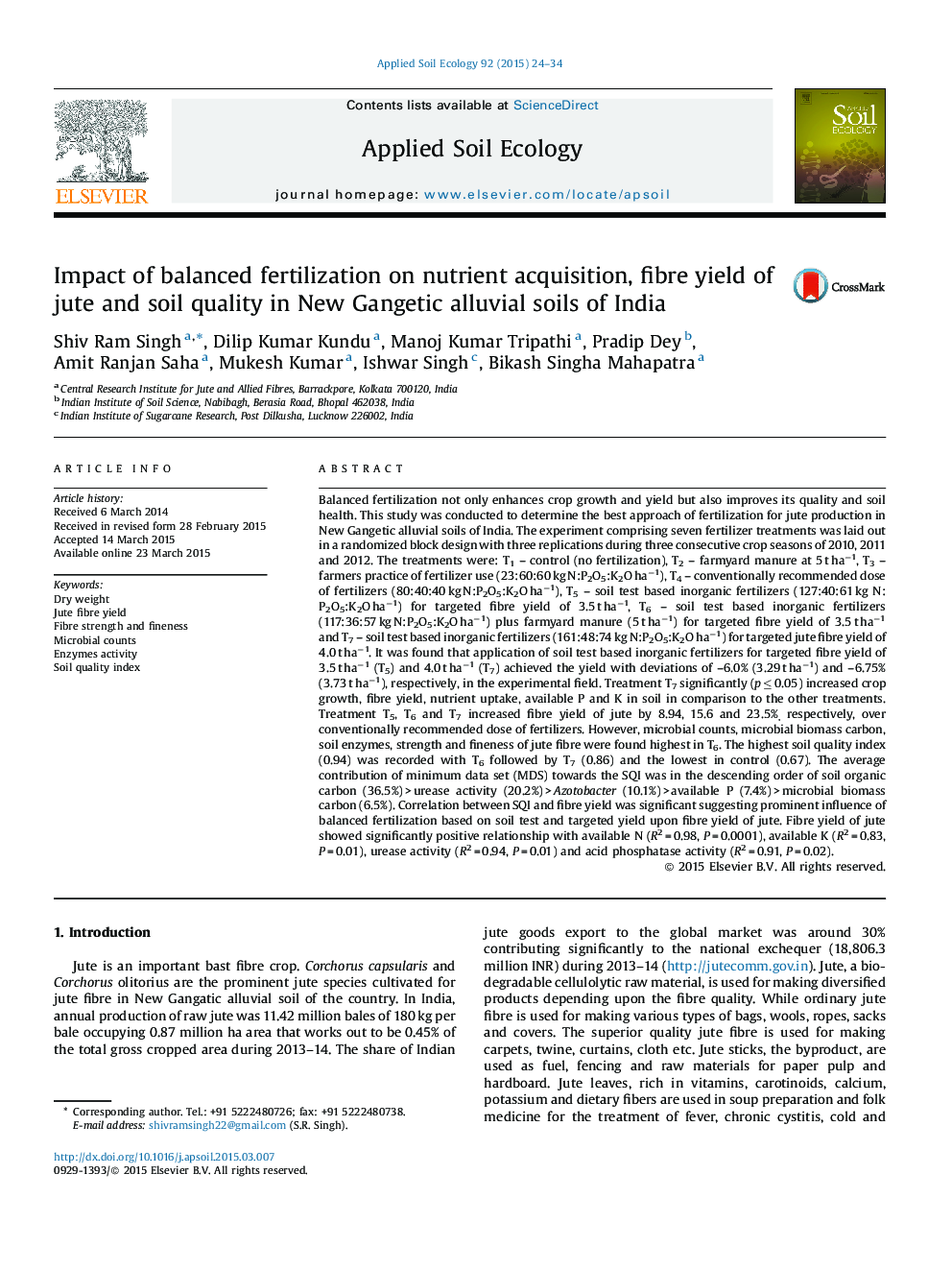| کد مقاله | کد نشریه | سال انتشار | مقاله انگلیسی | نسخه تمام متن |
|---|---|---|---|---|
| 4381990 | 1617791 | 2015 | 11 صفحه PDF | دانلود رایگان |
عنوان انگلیسی مقاله ISI
Impact of balanced fertilization on nutrient acquisition, fibre yield of jute and soil quality in New Gangetic alluvial soils of India
ترجمه فارسی عنوان
تأثیر بارورسازی متوازن بر روی دریافت مواد مغذی، تولید فیبر جوت و کیفیت خاک در خاکهای آلوویچ جدید گانگیک هند
دانلود مقاله + سفارش ترجمه
دانلود مقاله ISI انگلیسی
رایگان برای ایرانیان
کلمات کلیدی
وزن خشک، عملکرد فیبر جوت، قدرت فیبر و ریزش، شمارش میکروبی فعالیت آنزیم، شاخص کیفیت خاک،
موضوعات مرتبط
علوم زیستی و بیوفناوری
علوم کشاورزی و بیولوژیک
بوم شناسی، تکامل، رفتار و سامانه شناسی
چکیده انگلیسی
Balanced fertilization not only enhances crop growth and yield but also improves its quality and soil health. This study was conducted to determine the best approach of fertilization for jute production in New Gangetic alluvial soils of India. The experiment comprising seven fertilizer treatments was laid out in a randomized block design with three replications during three consecutive crop seasons of 2010, 2011 and 2012. The treatments were: T1 - control (no fertilization), T2 - farmyard manure at 5 t haâ1, T3 - farmers practice of fertilizer use (23:60:60 kg N:P2O5:K2O haâ1), T4 - conventionally recommended dose of fertilizers (80:40:40 kg N:P2O5:K2O haâ1), T5 - soil test based inorganic fertilizers (127:40:61 kg N:P2O5:K2O haâ1) for targeted fibre yield of 3.5 t haâ1, T6 - soil test based inorganic fertilizers (117:36:57 kg N:P2O5:K2O haâ1) plus farmyard manure (5 t haâ1) for targeted fibre yield of 3.5 t haâ1 and T7 - soil test based inorganic fertilizers (161:48:74 kg N:P2O5:K2O haâ1) for targeted jute fibre yield of 4.0 t haâ1. It was found that application of soil test based inorganic fertilizers for targeted fibre yield of 3.5 t haâ1 (T5) and 4.0 t haâ1 (T7) achieved the yield with deviations of -6.0% (3.29 t haâ1) and -6.75% (3.73 t haâ1), respectively, in the experimental field. Treatment T7 significantly (p â¤Â 0.05) increased crop growth, fibre yield, nutrient uptake, available P and K in soil in comparison to the other treatments. Treatment T5, T6 and T7 increased fibre yield of jute by 8.94, 15.6 and 23.5%, respectively, over conventionally recommended dose of fertilizers. However, microbial counts, microbial biomass carbon, soil enzymes, strength and fineness of jute fibre were found highest in T6. The highest soil quality index (0.94) was recorded with T6 followed by T7 (0.86) and the lowest in control (0.67). The average contribution of minimum data set (MDS) towards the SQI was in the descending order of soil organic carbon (36.5%) > urease activity (20.2%) > Azotobacter (10.1%) > available P (7.4%) > microbial biomass carbon (6.5%). Correlation between SQI and fibre yield was significant suggesting prominent influence of balanced fertilization based on soil test and targeted yield upon fibre yield of jute. Fibre yield of jute showed significantly positive relationship with available N (R2 = 0.98, P = 0.0001), available K (R2 = 0.83, P = 0.01), urease activity (R2 = 0.94, P = 0.01) and acid phosphatase activity (R2 = 0.91, P = 0.02).
ناشر
Database: Elsevier - ScienceDirect (ساینس دایرکت)
Journal: Applied Soil Ecology - Volume 92, August 2015, Pages 24-34
Journal: Applied Soil Ecology - Volume 92, August 2015, Pages 24-34
نویسندگان
Shiv Ram Singh, Dilip Kumar Kundu, Manoj Kumar Tripathi, Pradip Dey, Amit Ranjan Saha, Mukesh Kumar, Ishwar Singh, Bikash Singha Mahapatra,
